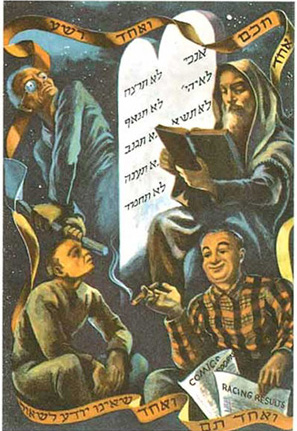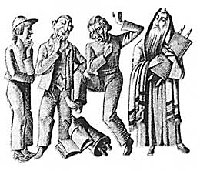
| Clashing
Cultures: Siegmund
Forst (Europe & U.S.A., 1958-59) |

Siegmund Forst
introduces his illustrated Haggadah in the following way: "This
old Jewish book speaks of sorrow and hope.... It appears in contemporary
dress, illustrated by one who himself has suffered the flames and escaped
them" (1941). The central Jewish cultural conflict in these drawings
lies between the Jewish socialist revolutionary and his elderly ultra-orthodox
Eastern European forebearers.
In the 1958 version, the wise old man lives by his faith in God and the
Torah but his age and his defensive posture reflect his threatened status
in a changing world. He looks worriedly to Heaven for salvation. The wicked
bespectacled, self-hating intellectual tramples the Torah displaying an
adolescent resentment against the old, dying order. The simpleton dressed
in a business suit and the child without questions wearing his American
baseball cap provide an attentive audience. For Forst, the Jewish revolutionary
has displaced the soldier as the representative of the wicked child. Forst
did not see the socialists as a legitimate continuation of the Jewish
ideal of liberation from bondage that was born in the exodus from Egypt.
In the 1959 version the wicked revolutionary who raises his ax against
the Ten commandments resembles Leon Trotsky (Lev Bronshtein), a Marxist
leader of the Bolshevik revolution (1917). The simple child is a sports
fan who loves gambling and smoking, while the fourth child is a passive
worker.
![]()